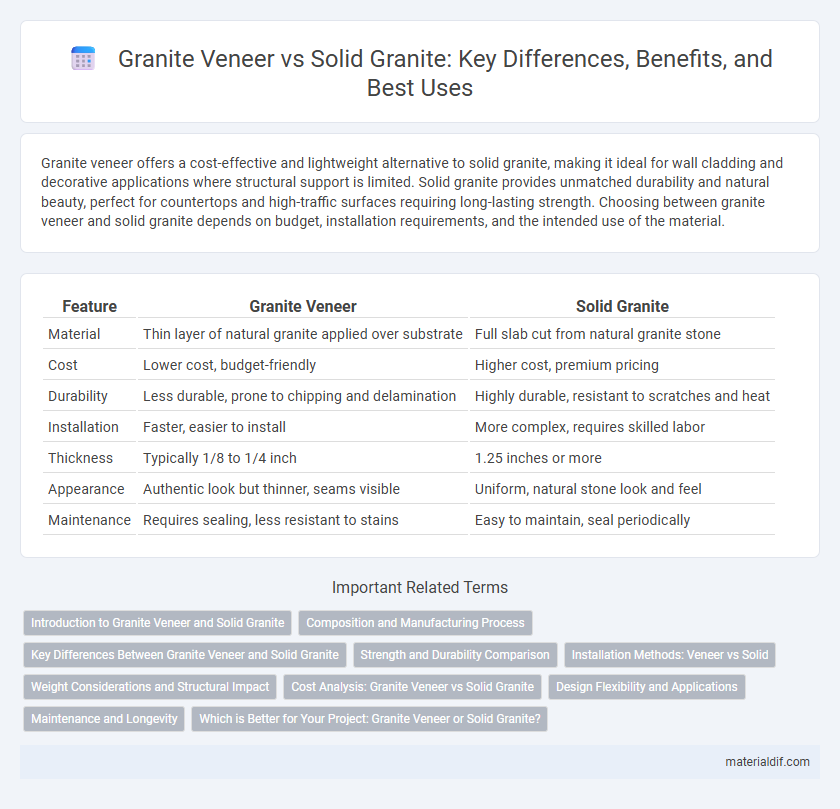Granite veneer offers a cost-effective and lightweight alternative to solid granite, making it ideal for wall cladding and decorative applications where structural support is limited. Solid granite provides unmatched durability and natural beauty, perfect for countertops and high-traffic surfaces requiring long-lasting strength. Choosing between granite veneer and solid granite depends on budget, installation requirements, and the intended use of the material.
Table of Comparison
| Feature | Granite Veneer | Solid Granite |
|---|---|---|
| Material | Thin layer of natural granite applied over substrate | Full slab cut from natural granite stone |
| Cost | Lower cost, budget-friendly | Higher cost, premium pricing |
| Durability | Less durable, prone to chipping and delamination | Highly durable, resistant to scratches and heat |
| Installation | Faster, easier to install | More complex, requires skilled labor |
| Thickness | Typically 1/8 to 1/4 inch | 1.25 inches or more |
| Appearance | Authentic look but thinner, seams visible | Uniform, natural stone look and feel |
| Maintenance | Requires sealing, less resistant to stains | Easy to maintain, seal periodically |
Introduction to Granite Veneer and Solid Granite
Granite veneer is a thin layer of natural granite applied over a substrate to provide the appearance of solid granite at a lower cost and weight. Solid granite consists of large slabs quarried directly from natural granite formations, offering unmatched durability and natural variation. Choosing between granite veneer and solid granite depends on factors such as budget, installation requirements, and desired aesthetic impact.
Composition and Manufacturing Process
Granite veneer consists of a thin layer of natural granite adhered to a backing material, offering a lightweight alternative to solid granite, which is quarried as a whole slab. Solid granite is composed of interlocking mineral crystals such as quartz, feldspar, and mica, formed through slow cooling of magma beneath the earth's surface, while granite veneer utilizes natural stone pieces bonded to a substrate during manufacturing. The manufacturing process of granite veneer involves cutting and polishing the thin stone layer before bonding, whereas solid granite slabs are cut directly from large blocks of quarried stone and then polished for installation.
Key Differences Between Granite Veneer and Solid Granite
Granite veneer is a thin layer of natural granite bonded to a substrate, offering a cost-effective and lighter alternative to solid granite, which is a full-thickness slab. Solid granite provides superior durability, heat resistance, and authenticity, making it ideal for high-traffic areas and long-term applications. Granite veneer is easier to install and more versatile for decorative use, but it lacks the robustness and repairability of solid granite.
Strength and Durability Comparison
Granite veneer offers a lighter alternative to solid granite, providing reasonable strength but with less impact resistance and durability under heavy use. Solid granite boasts superior compressive strength, making it highly resistant to chipping, scratching, and weathering over time. For applications requiring long-term durability and structural integrity, solid granite remains the optimal choice compared to granite veneer.
Installation Methods: Veneer vs Solid
Granite veneer installation involves adhering thin granite sheets to a structural substrate using specialized adhesives and mechanical fasteners, making it a lighter and more cost-effective option compared to solid granite. Solid granite slabs require full support with professional cutting, handling, and anchoring, often using mortar or epoxy to secure the heavy stone in place, necessitating skilled labor and reinforced cabinetry. The veneer method reduces structural load and installation time, while solid granite offers durability and a traditional countertop experience.
Weight Considerations and Structural Impact
Granite veneer typically weighs significantly less than solid granite, reducing load stress on underlying structures and making it ideal for facade applications and renovations. Solid granite slabs, with weights ranging from 18 to 22 pounds per square foot for standard thickness, demand robust support systems and can impact foundation integrity if not properly accounted for. Choosing granite veneer minimizes structural burden while maintaining the aesthetic and durability advantages of natural stone.
Cost Analysis: Granite Veneer vs Solid Granite
Granite veneer typically costs 30-50% less than solid granite due to its thinner profile and reduced material usage while providing a similar aesthetic appeal. Installation expenses for granite veneer are generally lower since it is lighter and easier to handle, reducing labor time and structural support requirements. In contrast, solid granite demands higher upfront investment and maintenance costs but offers greater durability and longevity over time.
Design Flexibility and Applications
Granite veneer offers superior design flexibility compared to solid granite due to its lightweight nature and ease of installation on various surfaces, enabling creative applications such as curved walls and intricate architectural details. Solid granite, known for its durability and natural beauty, is typically used for countertops, flooring, and heavy-duty outdoor applications where structural strength is essential. Choosing between granite veneer and solid granite depends on project requirements, budget constraints, and desired aesthetic impact.
Maintenance and Longevity
Granite veneer offers easier maintenance due to its thinner application, requiring less sealing and being less prone to chipping compared to solid granite. Solid granite boasts superior longevity with its full thickness, providing enhanced durability and resistance to wear over decades. Choosing solid granite ensures long-term investment value, while granite veneer suits projects prioritizing cost-efficiency and quicker installation.
Which is Better for Your Project: Granite Veneer or Solid Granite?
Granite veneer offers a cost-effective and lightweight alternative to solid granite, making it ideal for wall cladding and decorative applications where structural support is limited. Solid granite provides unmatched durability, heat resistance, and longevity, suitable for high-traffic areas like kitchen countertops and outdoor surfaces. Choosing between granite veneer and solid granite depends on project requirements such as budget, structural capacity, and desired aesthetic impact.
Granite Veneer vs Solid Granite Infographic

 materialdif.com
materialdif.com